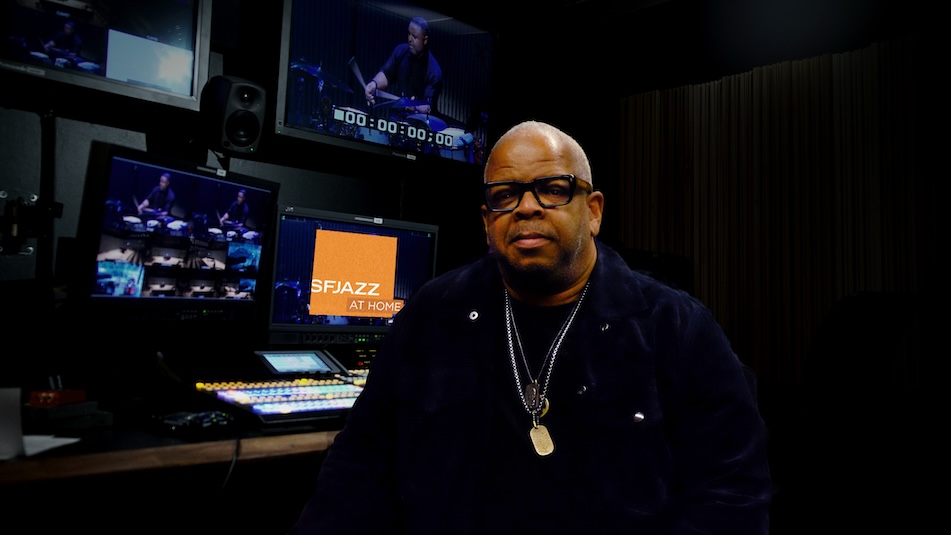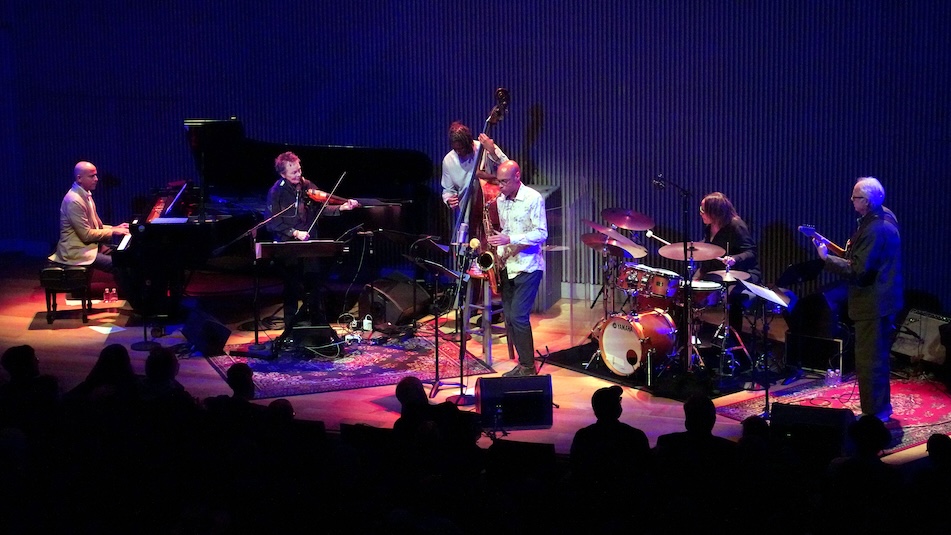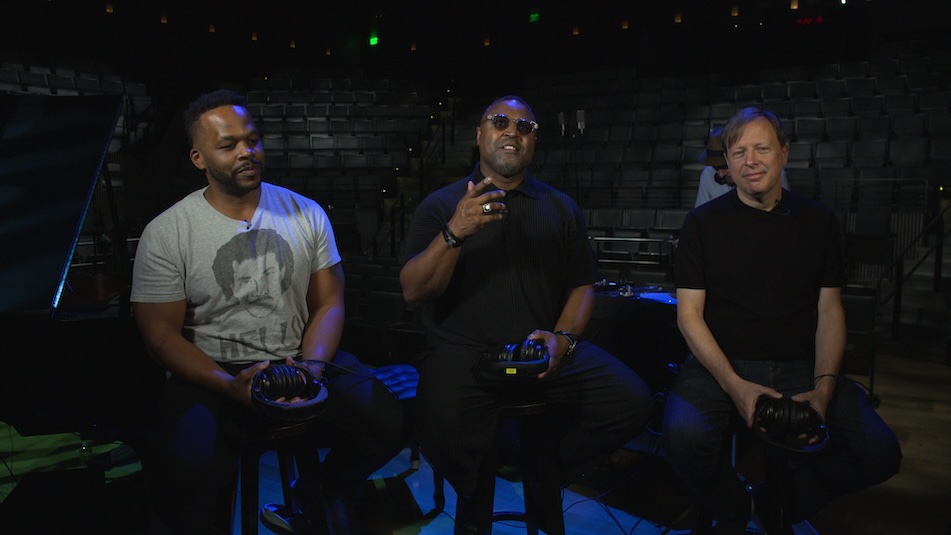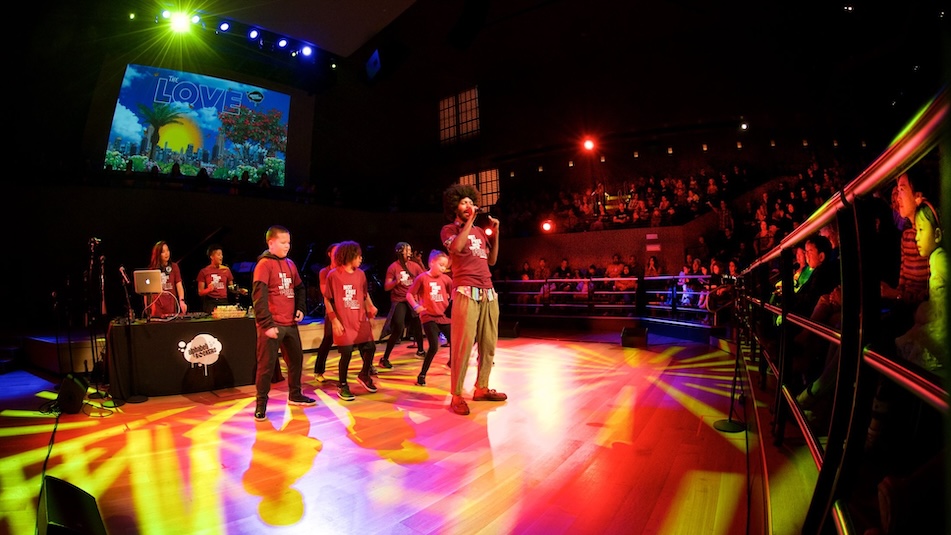SFJAZZ At Home 2.0:
reaching out to the globe-o-sphere
January 3, 2024 | by Richard Scheinin

Executive Artistic Director Terence Blanchard in the SFJAZZ video suite
SFJAZZ is about to launch an ambitious array of on-demand digital programming. Known as SFJAZZ At Home 2.0, it’s designed to increase access to the organization, diversify its audience, and establish a worldwide brand. Staff writer Richard Scheinin spoke to three of the program’s architects: Terence Blanchard, Greg Stern, and Ross Eustis.
Early in the pandemic, after shuttering its concert hall, SFJAZZ launched its “Fridays at Five” streaming performance series. Culled from the organization’s deep archive of pre-recorded shows, all filmed at the SFJAZZ Center in the years prior to COVID, it featured the likes of Herbie Hancock and Wayne Shorter, the Preservation Hall Jazz Band, Kamasi Washington, Dee Dee Bridgewater — heavyweights, week after week. Thousands tuned in.
Locked down at his house in New Orleans, trumpeter and composer Terence Blanchard was one of them: “I was saved by those streaming concerts from SFJAZZ,” recalls Blanchard, who is now the organization’s Executive Artistic Director. “I’d have a couple of friends over and we’d sit down and put it up on the big screen, and it made me realize the reach that SFJAZZ had. And while we’ve always done an amazing job of servicing the San Francisco Bay community, one of the things I’ve been thinking about lately is how SFJAZZ can keep servicing the broader community, the global community; I want to reach out into the `globe-o-sphere,’ if you will.”
Greg Stern, the CEO of SFJAZZ, reiterates the point: “We have this opportunity to build on what we’ve created in the Center over the past 10 years and share it with the world.”
That extended reach is becoming official: On Jan. 5, the organization will roll out SFJAZZ At Home 2.0, the expanded iteration of its digital programming wing. It will continue to feature “Fridays Live,” as the streaming series is now known. (Shows from the SFJAZZ Center stream on Fridays at 7:30 p.m., Pacific Time, with repeat broadcasts on Saturdays at 11 a.m.)
But “2.0” will add an impressive new centerpiece: 25 full-length concerts filmed at the SFJAZZ Center since its opening in 2013, featuring the likes of saxophonist Joshua Redman; multi-media experimentalist Laurie Anderson; the Sun Ra Arkestra; folk innovator Rhiannon Giddens; master percussionist Zakir Hussain; and drummer Cindy Blackman Santana’s all-star band with Carlos Santana, Vernon Reid and John Medeski, paying tribute to the late great Tony Williams. Every week, new concerts will be added to this digital library of SFJAZZ performances — all available on-demand.

(L–R): Pianist Edward Simon, former SFJAZZ Resident Artistic Directors Laurie Anderson, Marcus Shelby, Joshua Redman, Terri Lyne Carrington, and Bill Frisell (photo by RIck Swig)
A $5 monthly digital membership allows viewers anywhere in the “globe-o-sphere” to watch these performances whenever they want, and as often as they want.
“We’re flipping the switch: You no longer have to show up at a specific date or time to experience the concert,” explains Ross Eustis, Director of Digital at SFJAZZ. By breaking through time zone restrictions, he says, SFJAZZ is simplifying access to its digital programming and paving the way for an expanded global audience and brand. “It’s a game changer.”
It is sweetening the pot still further: The “2.0” rollout introduces video features in which musicians react to classic jazz albums (a monthly series called “Drop the Needle”), explain their creative processes and improvisational strategies (“In My Mind”), and deconstruct basic musical concepts like harmony, rhythm, and even freestyle rapping (“The Breakdown”). Each episode is short — five to eight minutes, as a rule — and packed with stories and information. They have an “up close” feel about them: “It’s almost like you’re hanging out with these guys,” Blanchard says. Upcoming episodes feature Kendrick Scott, Warren Wolf, and Chris Potter of the SFJAZZ Collective; drummer Eric Harland; and British saxophonist-rapper Soweto Kinch. In addition to the SFJAZZ At Home website and app, each new video series will be available across social media platforms, including SFJAZZ’s YouTube channel.
Percolating behind the scenes for several years now, they are the result of much meticulous production work and imagination: “When Ross told me about them,” Blanchard remembers, “I was like, `Dude, we’ve got to put these out for free. We’ve got to think of these as our TED Talks!”

SFJAZZ Drop the Needle: (L–R) SFJAZZ Collective members Warren Wolf, Kendrick Scott, Chris Potter
(Note: this episode will be posted in February 2024)
He expects the video nuggets to attract new fans, who hopefully will text them to friends or post them to their social media accounts, further amplifying the organization’s brand.
SFJAZZ has come a long way since March 2020 when the pandemic forced it to pivot — to move swiftly in a digital direction as a way of staying connected with listeners, maintaining community, and supporting musicians. One of the innovations of “Fridays at Five” was the Artist 50/50 Fund, which encouraged online viewers to send donations that were split between SFJAZZ and the artists to provide them with extra income. To date, the fund has raised nearly $1 million for artists, and the new rollout is designed to put even more dollars in performers’ pockets. It will continue to encourage donations during live streams, while also allowing musicians to earn additional revenue based on the number of on-demand views.
“That’s huge, because we’re here to support the artists,” says Blanchard. “But as with any arts organization, we’re always dealing with a balancing act — between the fiscal bottom line and the artistic soul of the place.”
Stern agrees. This season, SFJAZZ is enjoying robust ticket sales, exceeding pre-pandemic levels. But there are only so many nights to the year, and only so many seats to be filled. Like other arts organizations, SFJAZZ faces rising costs — and is no longer receiving the government grants that helped it weather the pandemic. To keep growing the organization, new revenue streams need to be developed: “Just from a business perspective,” he says, the digital expansion “makes sense.”
Since 2020, around 20,000 viewers have signed up as digital members — but they have tended to drop in and out of the program. By expanding offerings and making them available on-demand, SFJAZZ hopes to convince members to stick around. Stern has set an initial goal of establishing a permanent base of 10,000 digital members, up from the current 2,500. (This would be in addition to the 17,000 normal, non-digital-only members, who’ll continue to receive access to SFJAZZ At Home as a benefit.)
Beyond that, he notes that “2.0” dovetails with the organization’s wider trajectory. SFJAZZ recently published a strategic plan to guide it through the next three-to-five years. One “pillar” of the plan is “Digital Transformation,” which Stern defines as “leveraging digital technology to accelerate the broad objectives of the organization.”
Other pillars include “Diversity, Equity, Inclusion and Access” and “Audience Development and Community Engagement.” Blanchard says the digital piece is “in sync” with the whole strategic package: “Everything is tied together.”
For starters, the $5 monthly membership fee is designed to appeal to music lovers at all economic levels, including in marginalized communities in the Bay Area and beyond. The idea is to ease and encourage access to the organization, breaking down barriers or any perception that programming at SFJAZZ is an elite thing. Online educational programs — including free, on-demand streams of Family Matinee concerts — can help spread the word about jazz, unlocking its history, and making it clear that the music springs from the African-American and Afro-Caribbean communities.

SFJAZZ Family Matinee: Alphabet Rockers
“I’m big on education,” Blanchard says. “I want to bring more kids to the hall. I want to demystify the organization.”
Ultimately, the goal is to grow the audience, expanding its ethnic diversity, and bridging generations of listeners — both online and in the hall itself.
Stern says the digital platform “expresses our point of view on a wide variety of issues related to the art form.” Brainstorming on the phone, he imagines that future online projects could delve into the history of the music, addressing themes of “jazz and gender, jazz and civil rights. You could do something on how Louis Armstrong was an innovator in the midst of incredible racism in New Orleans.” There’s room for a light touch, too: He plans to commission a 90-second animation based on a 2021 New Yorker comic strip (by artist Paul Rogers) about saxophonist Paul Desmond’s infatuation with Audrey Hepburn.
Blanchard enjoys this kind of wide-open thinking. He has more ideas, and not only about “having a shelf of digital media.” For instance, he wants to elevate the profile of SFJAZZ Records — the organization’s in-house label, for which the SFJAZZ Collective records. He imagines signing young artists to the label. He imagines booking double-bills in Miner Auditorium to showcase young musicians who are too widely known to play in the club-like Joe Henderson Lab but not well-enough known to play the 700-seat Miner on their own. He has a tentative name for this future series: “Terence Blanchard’s Upswing.”
“It’s a new day,” he says. “It’s not like we can rely on radio play or big record companies to get the word out about the music. It’s time for some creative marketing. We have to be a part of the solution.”
A staff writer at SFJAZZ, Richard Scheinin is a lifelong journalist. He was the San Jose Mercury News' classical music and jazz critic for more than a decade and has profiled scores of public figures, from Ike Turner to Tony La Russa and the Dalai Lama.
